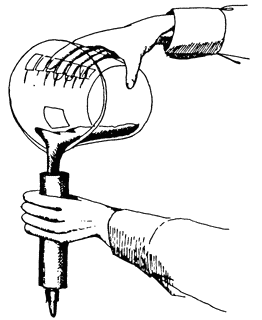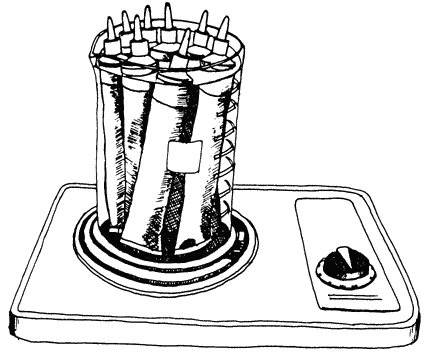

The preparation of wheat starch paste for use in conservation is a time-consuming process. Storage of the product requires special considerations for the prevention of mold and for retarding spoilage. Oftentimes, only a small amount is used during the work week, leaving the remainder to spoil.
Some authors have suggested recipes, methods of preparation and storage ideas. The use of the microwave to save on cooking tine has proved valuable, while the use of preservatives, such as orthophenylphenol and thymol, has extended the usable life of the paste. Our suggestion is for an alternative method for storing cooked pastes, one which leaves the working qualities of the paste unchanged in all respects.
In 1974, John Williams, Research and Testing Officer at the Library of Congress, suggested that Keogum, a preglutenized corn starch, could be prepared and then sterilized in aluminum tubes for storage. (This paste was used for mending paper and basketware.) Essentially his method was a process used to produce commercial adhesives. A slurry of 10 g starch to 500 ml water was brought to 90°C on a hot plate, with constant stirring. Next, 300 g starch dispersed in 750 ml water was stirred into the slurry. The slurry was immediately poured into aluminum tubes, which were quickly crimped at the ends. The caps were removed and each tube was slightly squeezed to bring the slurry up to the surface of the orifice. The caps were then securely replaced. All the assembled tubes were then placed in a boiling water bath, with the caps protruding out of the water. The tubes were sterilized by boiling for 30 minutes. They could be removed immediately, but were usually left until the water cooled. If the starch and water separated after prolonged storage, it could be regenerated to a creamy consistency by boiling in the closed tubes for 1/2 hour.
Keogum was most often used for mends rather than backings. This corn starch has not been available since 1987 and is not widely used today.
We have adapted the method of sterilizing in tubes to the more widely used wheat starch paste, with one important change: the aluminum tubes have been replaced by epoxy phenolic resin lined aluminum tubes. This has addressed our concerns about possible contamination of the paste from direct contact with aluminum. The following method was first employed in the lab in 1986 and will work with paste which has already been prepared (either microwaved or cooked by conventional means). We have used 65 g wheat starch and 500 ml deionized water to yield eight 2-oz. tubes. So far, these tubes have lasted up to two and a half years, stored at room temperature, without spoiling and with no apparent loss of tack. The paste must be squeezed to the top of the tube after each use to prevent bacterial contamination.


Tubes are available in a variety of sizes and shapes from Sheffield Tube Corporation, 170 Broad Street, P0 Box 351, New London, CT 06320. Their toll-free number is 1-800-222-1087. Small quantities of tubes may be ordered, but delivery depends on the manufacturer's schedule of delivery for large orders; small numbers of tubes are treated as "end-of-run" orders, and are tacked onto larger runs of tubes in the same size.
The costs involved in preparing paste using this method include the following: $40 for 144 tubes and $16 for one pound of dry wheat starch. Cost per 2-oz. tube of paste figures around $2.67, excluding the cost of deionized water used to prepare the paste.
The authors wish to thank Kevin Murphy for the illustrations.